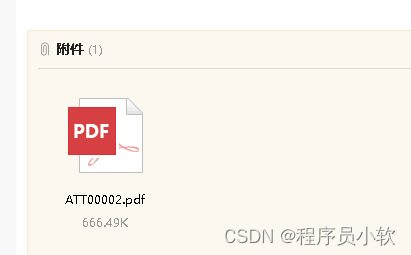springboot带有spring-boot-starter-mail包,可用于发送邮件。但是SpringBoot mail默认只能配置一个账号,配置如下:
spring:
mail:
protocol: smtp
host: smtp.126.com
port: 25
username: xxxx@126.com
password: xxxxxxx
default-encoding: UTF-8
properties:
mail:
smtp:
socketFactoryClass: javax.net.ssl.SSLSocketFactory
debug: true
为了支持多个账号,需要自定义IOC的机制。
查看Springboot mail相关的源代码,发现邮件的配置主要是在类org.springframework.boot.autoconfigure.mail.MailSenderPropertiesConfiguration里完成,这里会配置JavaMailSender和MailProperties
因此解决问题的关键是重写MailSenderPropertiesConfiguration类,能够按照自定义的prefix配置单独的JavaMailSender和MailProperties。
代码如下:
- 引入依赖
<dependency>
<groupId>org.springframework.boot</groupId>
<artifactId>spring-boot-starter-mail</artifactId>
</dependency>
<!-- 使用 thymeleaf 编写邮箱内容模板 -->
<dependency>
<groupId>org.springframework.boot</groupId>
<artifactId>spring-boot-starter-thymeleaf</artifactId>
</dependency>
- 配置 yml:
spring:
mail:
# springBoot原配置 这里做默认配置
protocol: smtp
host: xxxx.xxxx.com
port: 25
username: xxxx@xxxxx.com
password: xxxxx
default-encoding: UTF-8
properties:
fromName: 程序员小软(Boo)
mail:
# smtp:
# ssl:
# enable: true
# socketFactoryClass: javax.net.ssl.SSLSocketFactory
debug: false
# 自定义扩展的配置 (支持多邮箱)
mails:
- protocol: smtp
host: smtp.126.com
port: 25
username: xxxxx@126.com
password: xxxxx
default-encoding: UTF-8
properties:
mail:
smtp:
socketFactoryClass: javax.net.ssl.SSLSocketFactory
# 是否开启debug模式 开启后会打印邮箱发送的详细信息
debug: true
- protocol: smtp
host: smtp.163.com
port: 25
username: xxxxx@163.com
password: xxxxx
- protocol: smtp
host: xxxxx
port: 0000
username: xxxxx
password: xxxxx
thymeleaf:
mode: HTML
encoding: utf-8
# 禁用缓存
cache: false
import org.springframework.boot.autoconfigure.mail.MailProperties;
import org.springframework.boot.context.properties.ConfigurationProperties;
import java.util.List;
/** 加载邮箱账号配置列表
* description: BooMailProperties <br>
* date: 2024/3/26 13:44 <br>
* author: Boo <br>
* version: 1.0 <br>
*/
@ConfigurationProperties(
prefix = "spring.mail"
)
public class BooMailsProperties {
private List<MailProperties> mails;
public List<MailProperties> getMails() {
return mails;
}
public void setMails(List<MailProperties> mails) {
this.mails = mails;
}
}
import org.springframework.beans.factory.annotation.Autowired;
import org.springframework.boot.autoconfigure.mail.MailProperties;
import org.springframework.mail.javamail.JavaMailSender;
import org.springframework.mail.javamail.JavaMailSenderImpl;
import org.springframework.stereotype.Component;
import org.springframework.util.CollectionUtils;
import java.util.HashMap;
import java.util.List;
import java.util.Map;
import java.util.Properties;
/** 获取邮件发送者
* description: MailSenderFactory <br>
* date: 2024/3/26 14:24 <br>
* author: Boo <br>
* version: 1.0 <br>
*/
@Component
public class MailSenderFactory {
@Autowired
BooMailsProperties booMailsProperties;
private Map<String, JavaMailSender> mailSenderMap;
/** 功能描述:
* @param booMailsProperties 多个邮箱配置
* @param mailPropertiesCommon springBoot原有的邮箱配置 这里做默认配置用
* @Author: Boo
* @Date: 2024/4/7 14:00
*/
public MailSenderFactory(BooMailsProperties booMailsProperties,
MailProperties mailPropertiesCommon){
List<MailProperties> emailArr = booMailsProperties.getMails();
if (CollectionUtils.isEmpty(emailArr)){
emailArr.add(mailPropertiesCommon);
log.error("You must configuration the mails for spring.mail!");
return;
}
mailSenderMap = new HashMap<>();
for (MailProperties mailProperties : emailArr) {
copyNonNullProperties(mailPropertiesCommon, mailProperties);
JavaMailSenderImpl sender = new JavaMailSenderImpl();
this.applyProperties(mailProperties, sender);
mailSenderMap.put(mailProperties.getUsername(), sender);
}
}
/**
* 获取邮件发送者
* @param username
* @return
*/
public JavaMailSender getMailSender(String username){
return mailSenderMap.get(username);
}
private void applyProperties(MailProperties properties, JavaMailSenderImpl sender) {
sender.setHost(properties.getHost());
if (properties.getPort() != null) {
sender.setPort(properties.getPort());
}
sender.setUsername(properties.getUsername());
sender.setPassword(properties.getPassword());
sender.setProtocol(properties.getProtocol());
if (properties.getDefaultEncoding() != null) {
sender.setDefaultEncoding(properties.getDefaultEncoding().name());
}
if (!properties.getProperties().isEmpty()) {
sender.setJavaMailProperties(this.asProperties(properties.getProperties()));
}
}
private Properties asProperties(Map<String, String> source) {
Properties properties = new Properties();
properties.putAll(source);
return properties;
}
/** 功能描述: 拷贝target中没有的属性
* @param source
* @param target
* @return: void
* @Author: Boo
* @Date: 2024/4/7 14:01
*/
public void copyNonNullProperties(Object source, Object target) {
BeanWrapper sourceWrapper = PropertyAccessorFactory.forBeanPropertyAccess(source);
BeanWrapper targetWrapper = PropertyAccessorFactory.forBeanPropertyAccess(target);
PropertyDescriptor[] propertyDescriptors = BeanUtils.getPropertyDescriptors(source.getClass());
for (PropertyDescriptor propertyDescriptor : propertyDescriptors) {
String propertyName = propertyDescriptor.getName();
Object srcValue = sourceWrapper.getPropertyValue(propertyName);
Object targetValue = targetWrapper.getPropertyValue(propertyName);
if (srcValue != null && targetValue == null) {
targetWrapper.setPropertyValue(propertyName, srcValue);
}
if (srcValue != null && srcValue instanceof Map && targetValue instanceof Map) {
copyNonNullProperties4Map(srcValue, targetValue);
}
}
}
/** 拷贝target中没有的属性 */
private void copyNonNullProperties4Map(Object srcValue, Object targetValue) {
Map srcMap = (Map) srcValue;
Map targetMap = (Map) targetValue;
srcMap.forEach((k, v) -> {
if (targetMap.get(k) == null) {
targetMap.put(k, v);
}
});
}
}
import lombok.Synchronized;
import lombok.extern.slf4j.Slf4j;
import org.springframework.beans.factory.annotation.Autowired;
import org.springframework.boot.autoconfigure.mail.MailProperties;
import org.springframework.mail.MailAuthenticationException;
import org.springframework.mail.MailException;
import org.springframework.mail.javamail.JavaMailSender;
import org.springframework.mail.javamail.MimeMessageHelper;
import org.springframework.stereotype.Component;
import org.thymeleaf.TemplateEngine;
import org.thymeleaf.context.Context;
import javax.mail.MessagingException;
import javax.mail.internet.MimeMessage;
import java.io.File;
import java.util.Arrays;
import java.util.Date;
import java.util.List;
/**
* description: EmailSender <br>
* date: 2023/12/4 11:07 <br>
* author: Boo <br>
* version: 1.0 <br>
*/
@Component
@Slf4j
public class EmailSender {
private List<MailProperties> mailPropertiesList;
private int activitedMailIndex = 0;
private String activitedMailDate = "";
@Autowired
BooMailsProperties booMailsProperties;
@Autowired
MailSenderFactory mailSenderFactory;
@Autowired
TemplateEngine templateEngine;
public EmailSender(BooMailsProperties booMailsProperties) {
// 参数mail.mime.splitlongparameters 在linux下 会默认为 true,附件名过长,就会被截断
System.getProperties().setProperty("mail.mime.splitlongparameters", "false");
this.mailPropertiesList = booMailsProperties.getMails();
}
public boolean send(String[] mailAddressArr,
String subject,
String title,
String text,
File file) {
String errMsg = "";
initActivitedMailIndex();
MailProperties mailProperties = mailPropertiesList.get(activitedMailIndex);
JavaMailSender javaMailSender = mailSenderFactory.getMailSender(mailProperties.getUsername());
MimeMessage msg = javaMailSender.createMimeMessage();
if (mailAddressArr == null || mailAddressArr.length < 1){
throw new RuntimeException("Sending email failed: The recipient's email must not be empty!");
}
// 收件邮箱去重
if (mailAddressArr.length > 0){
mailAddressArr = Arrays.stream(mailAddressArr)
.map(a -> a.trim())
.distinct().toArray(String[]::new);
}
// 校验邮箱格式
for (int i = 0; i < mailAddressArr.length; i++) {
if (!Validator.isEmail(mailAddressArr[i])){
throw new RuntimeException(String.format("The mail [%s] incorrect format!", mailAddressArr[i]));
}
}
try {
MimeMessageHelper helper = new MimeMessageHelper(msg,true);
//设置邮件元信息
helper.setTo(mailAddressArr);
// 自定义发送方名称
String fromName = mailProperties.getProperties().get("fromName");
if (StrUtil.isNotBlank(fromName)){
helper.setFrom(String.format("%s<%s>", fromName, mailProperties.getUsername()));
}else {
helper.setFrom(mailProperties.getUsername());
}
helper.setSubject(subject);
helper.setSentDate(new Date());
if (file!=null && file.exists()){
// helper.addAttachment(file.getName(), file);
// 防止附件名乱码
helper.addAttachment(MimeUtility.encodeWord(file.getName(),"utf-8","B"), file);
}
//模板渲染
Context context = new Context();
context.setVariable("title", title);
context.setVariable("text", text);
String mail = templateEngine.process("mail/def", context);
helper.setText(mail, true);
javaMailSender.send(msg);
return true;
} catch (MessagingException e) {
changeMail();
errMsg = e.getMessage();
}catch(MailAuthenticationException e){
changeMail();
errMsg = e.getMessage();
}catch(MailException e){
changeMail();
errMsg = e.getMessage();
}
throw new RuntimeException(String.format("Send email fail: %s, please adjust or try again!", errMsg));
}
@Synchronized
private void changeMail() {
if (activitedMailIndex < mailPropertiesList.size() - 1){
activitedMailIndex ++;
}else {
activitedMailIndex = 0;
}
}
@Synchronized
private void initActivitedMailIndex() {
String today = DateUtil.today();
if (!activitedMailDate.equals(today)){
activitedMailIndex = 0;
activitedMailDate = today;
}
}
}
问题
- JavaMail发送带附件邮件时附件名变成了ATT00002、未命名的附件、或者附件名显示不全的原因及解决方案

原因:附件名过长,触发了校验导致进行了截取
解决方案1:文件名缩短
解决方案2:干掉这个校验-在调用MimeBodyPart.setFileName(String fileName)之前加一行代码:
System.getProperties().setProperty("mail.mime.splitlongparameters", "false");
参数mail.mime.splitlongparameters 在linux下 会默认为 true,附件名过长,就会被截断
以上代码只需要配置一次,因此可以写到启动类中;我这里写在了EmailSender的构造函数中,这样容器启动会执行一次。
- debug模式
日志打印超级长的内容(有附件),线上建议关闭 — 配置spring.mail.properties.mail.debug=false








 本文介绍了如何在SpringBoot应用中,通过自定义配置文件支持多个邮箱账号发送邮件,包括重写MailSenderPropertiesConfiguration并使用JavaMailSender和MailProperties来实现这一功能。
本文介绍了如何在SpringBoot应用中,通过自定义配置文件支持多个邮箱账号发送邮件,包括重写MailSenderPropertiesConfiguration并使用JavaMailSender和MailProperties来实现这一功能。














 2438
2438











 被折叠的 条评论
为什么被折叠?
被折叠的 条评论
为什么被折叠?








